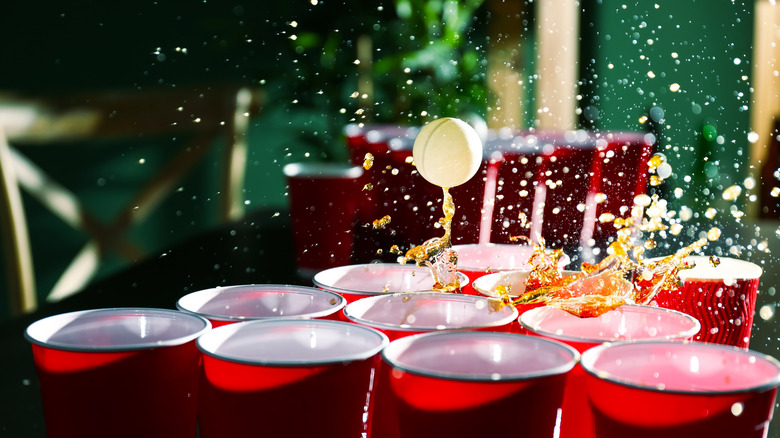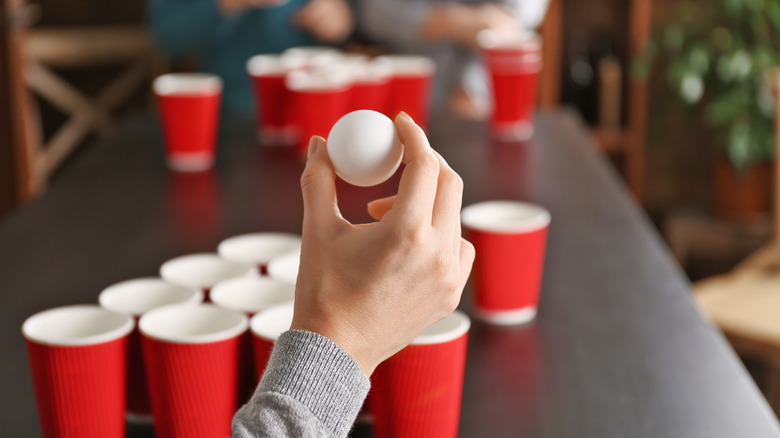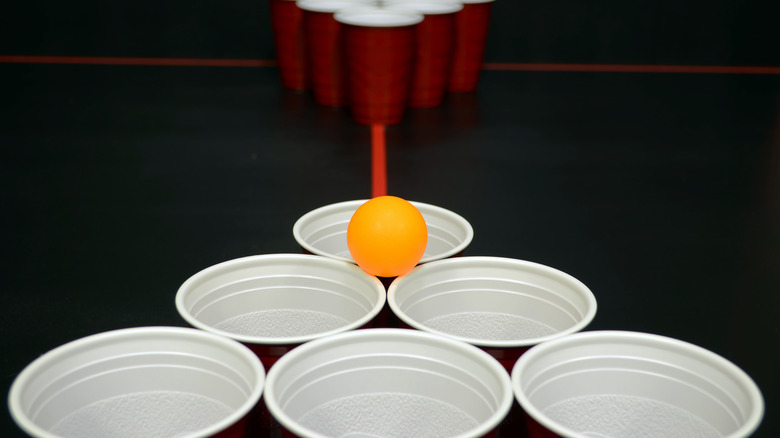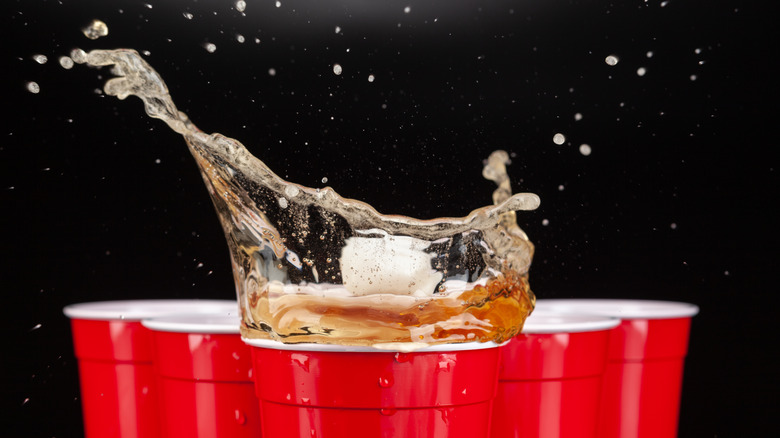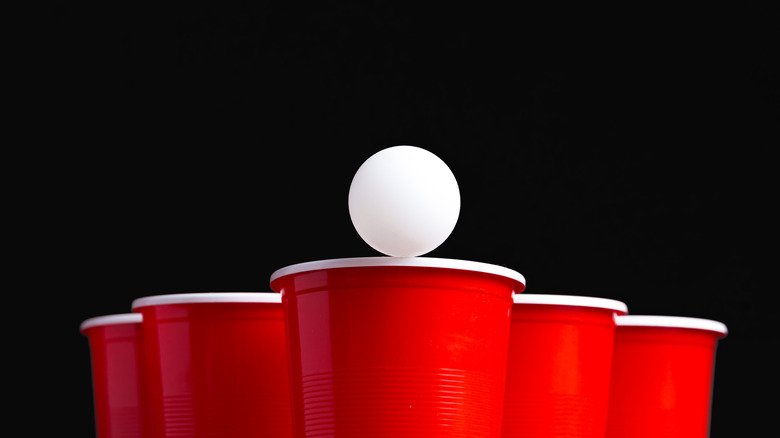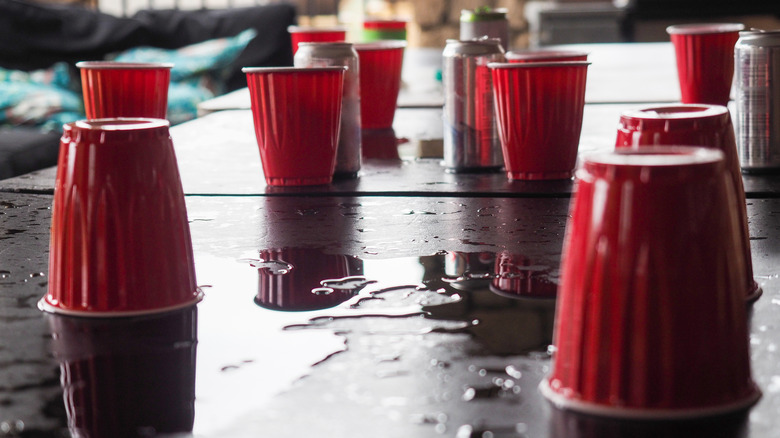How To Actually Play Beer Pong
Beer pong is something you may hate to love or love to hate. Just the name incites visions of attending house parties, letting loose, and partying! There is something paradoxically noble about the game. It's quintessentially American in nature and a rite of passage into American drinking culture, although some enthusiasts, such as those over at Pong University, argue that the game originated in Lebanon, which is why an alternative name for the game is Beirut. Stateside, however, beer pong is believed to have originated at Dartmouth College around the 1950s, according to Food52. And while there isn't concrete evidence supporting this, there is an archived letter from a Dartmouth senior published in The New York Times in 1972 asking about the world's record for the longest game of beer pong.
As legend has it, students began shooting ping pong balls into empty cups that were left on the playing table. According to Food52, that OG Beer Pong was even played with ping pong paddles. Eventually, with the creative ingenuity and the desire to drink that define college students, the cups were filled with beer, and a new drinking game emerged. While most no longer use paddles, the game remains deep in American culture. There's a reason why we've clung to this game. With so much history and so many variations, there's a lot to learn, both old and new, about this classic party game. Below is all you need to know about the game and how to play it.
Supplies
Beer pong can be as dressed up or as dressed down as you'd like, and that's part of the beauty that surrounds the game. It's really the desire to play beer pong that's the most important! But, still, there are a few things you will need. One critical tool in your arsenal, however, is the table. If we are to believe the guidance from Food52, the table you're playing on should be roughly the size of a ping-pong table. According to the specialists over at Measuring Stuff, the standard beer pong table should be about 8 feet in width and 2 feet in length. A dining table makes a suitable substitute for a game of beer pong, although there's no shortage of custom beer pong tables floating around the internet. But, really, any large table will do!
Perhaps the most iconic thing on the beer pong table is going to be the red SOLO cup. These bright red cups introduced in the 1970s have all but become synonymous with parties: They're visually bold and easy to clean up. While they're tried and true party companions, their size is also perfectly equipped for beer pong. It may be nice to make some more eco-friendly adaptations, though, like swapping out one-use plastics for mugs or even reusable cups. Some retailers have even made sustainable versions of the classic cup.
Be sure to have plenty of beer or your drink of choice on hand. Most importantly, you need some ping pong balls.
Beer or water?
The main objective of beer pong is to drink beer, of course. For decades, the game called for cups filled with beer. Once the ball lands into a cup, the losing player would drink beer directly from that cup. It seems that at least some of those in Gen Z have moved past this. One Tiktok posted in 2022 with around 174,000 likes showed the red cups being filled with water and pondered how anyone could drink directly from a beer pong cup. They kept their beers separate from the playing cups, though not everyone buys into this version of the game. "It's not beer pong with water," one commenter said.
It doesn't take a genius to figure out that beer pong can get pretty grody. After all, the ball is passing through a lot of hands from a lot of different people. It also rolls around the table, on the floor, and into nooks and crevices. In an article from Vice, two university professors explained their efforts to find out just how dirty those beer pong balls could get. Their study found that not only did ping pong balls get extremely dirty, especially when the game is played outside, but also that bacteria picked up by the ball transfers to the beer within seconds. So, when racking up at the pong table, it makes sense to either have a separate drinking cup or alternatively, as Vice suggests, to sterilize the ping pong balls after every round.
Set up teams
You need at least two people to play beer pong, though teams can add a lot of excitement to the whole ordeal! After all, what better way to get to know someone, or get your flirt on, than by playing a game together? You have the opportunity to share a win or a loss, but definitely a beer! One writer and beer pong enthusiast over at Total Frat Move boldly claims that playing beer pong worked as a perfect way to test the waters of a potential relationship. Despite the ups and downs, he maintained that good chemistry in beer pong without fail translated to good chemistry outside the game! Whether or not this translated to the trappings of a deeper relationship, however, didn't seem to be apparent.
"Relationships are about give and take, chemistry, and a solid team dynamic," the writer notes. "If a girl is a fun pong partner, she'll be a good girlfriend. Simple as that."
Maybe you're not looking for love with a beer pong partner. That's okay. Teaming up with a good friend or even a stranger can still make for a really astounding game of beer pong. According to Pong University, beer pong is officially a game of four players, with two people per team. Every round alternates, with two players on one team each getting a shot before the opposing team takes their shots. This doesn't mean, however, that alternates can't sub in and enjoy some pong of their own!
The game has official rules
Unlike other drinking games, such as King's Cup, there are codified rules to beer pong. After all, it's an official sport, complete with its own official league and a tournament known as The World Series of Beer Pong, as observed by BPong. Thanks to this set of rules, which will be clarified in greater detail below, players have a specific touchstone to guide their gameplay in whatever setting.
There are a few basics, though, that are good to know before getting into the nitty-gritty in the rulebook. At the start of the game, six to 10 cups need to be set up in a pyramid shape at each end of the table (via BPong). Of course, this should be done on a standard beer pong table, i.e. one that measures about 8 feet in length. While the game typically uses 12- or 16-ounce cups that players have to shoot a ball into, the holy grail of beer pong clarifies that there is no need to drink that much in this game. Drinking games, while about indulgence, are also about recognizing limits. So, do make sure that your cup, and your tolerance, do not filleth over!
Who makes the first shot?
The first shot sets the tone for the rest of the game. There's no pressure here! But, who exactly gets to make this first shot? In beer pong, there's actually a unique approach to it. The game begins with what many call "eye to eye" or "eyes," where one player from each team maintains eye contact with the other as they both take aim and fire away (via Beer Pong All-Stars). If the first two players miss, or if alternatively they both make the shot, their teammates then step up to do the same. Whoever makes the shot when their opponent misses will get to lead the table. However, it's critical to note that during "eye to eye" no cups will be removed from the table, per the rules.
It's only once the real game begins that the drinking can begin. If you want to make sure that you're not endlessly stuck in the beginning round, there are a few tricks to help you make that shot. The analysts over at Dimensions suggest an arc shot, which as the name implies, calls for throwing the ball at a large curved angle into the cup. After the initial round of eye to eye, the winning team can remain for another round and go first by exercising seniority over newly entering teams.
Watch your elbows
According to Dimensions, there are three types of shots that'll help bring you to victory at the beer pong table: the previously mentioned arc shot, the laser (or fastball) shot, and bounce shot. While the arc shot "arches" the ball into the beer pong cup, it moves a bit slowly and can easily be deflected by other players in specific moves we'll go into further detail on below. The laser, or fastball, shot uses a much tighter angle and will be directly, and quickly, thrown into the cup (via Dimensions). This shot is very hard to deflect, and those who can master it can be the absolute key to undefeated victory in the beer pong line-up.
Finally, the bounce shot is quite possibly the hardest shot to make, with the biggest reward. As Dimensions clarifies, bounce shots are made by bouncing the ball past the center line and into a beer pong cup at the opposite end of the table in one bounce. Only with a bounce shot is the opposing team allowed to slap the ball away. Suffice to say, it's hard to make a bounce shot! But, if this difficult shot is successfully made, the opposing team needs to take two cups off the table. There are a lot of ways to make your shots — just make sure your elbow doesn't pass the edge of the beer pong table (via Beer Pong All-Stars and Dimensions), as this is in violation of the "elbows" rule!
Fixing, racking, and re-racking
While the cups initially need to be arranged in a pyramid at the beginning of the game, this need not be the case as the game progresses and more cups are removed. It's possible to fix, rack, and re-rack the cups so that you have the best shot at making a shot, although under specific conditions. As BPong specifies, fixing can be done at any point in the game. But do take heed. According to Dimensions, cups can only be moved at the beginning of the team's turn. All this move does is "fix" the cups, so that they return to the default pyramid shape that they should be in. Racking and re-racking are a bit different from fixing, as they both involve arranging the cups into any shape. This can only be done twice per team during the game. Notably, re-racks can not be done if there are three cups left on the table that are not touching (via Beer Pong All-Stars).
Specific racks can have a specific effect on the game. The notorious "island" re-rack holds a lot of weight in the game. This specific shape involves isolating one cup from the others, and thus making an "island" (via Beer Pong All-Stars). If the island shot is made, two cups can be removed. A successful bounce shot can even lead to all three cups being removed! While it is one of the harder shots to make, the island arrangement can be the most rewarding.
Fingering and blowing
Of course, the opposing team doesn't need to sit by and look pretty while they wait to see if the other team makes its shots. Granted, you can't swat any of the shots away from the cup, unless it's a bounce shot. Nonetheless, there are a few rebuttal tactics you can use to reverse a successfully made shot!
To keep this explanation as PG as possible, in beer pong it's possible to "finger" or "blow" the ball out of the cups (via Beer Pong All-Stars). Fingering and blowing are ways of canceling a made shot and making sure the cup stays on the table, but they can only be done under specific situations. BPong specifies that there's a little bit of etiquette when it comes to fingering and blowing, and it needs to be specified at the beginning of the game if either of these moves is allowed to be used.
According to BPong, fingering is done when the ping pong ball is circling around the interior of the cup but before it touches the drink. The ball can, in this situation, be scooped out with one finger and the cup can remain on the table. The second tactic, on the other hand, involves blowing the ping pong ball out of the cup. This, like fingering, can be done as the ball is circling the cup. Unlike fingering, however, according to BPong, balls can be blown out of the cup even after they've touched the beer.
Rollback and the winning shot
In beer pong, every time a ball is shot into a cup, the cup is removed from the table and the losing team takes a drink. Once the game really gets rolling, well-seasoned beer pong players will be surprised at just how fast the cups will fly off of the table! One of the keys to winning beer pong is making as many (successful) shots as you can. An easy way to dip into a few extra shots is with rollbacks. According to BPong, if the ping pong ball "rolls back" over the center line to the team that originally made the shot without ever leaving the table, said team is entitled to take another shot.
Alternatively, BPong notes that the death cup is also a possibility for an "easy" win, if those who are playing recognize this rule. The death cup is any cup in which a shot has been made, but its contents haven't fully been consumed. If the opposing team makes the shot into the already removed cup, the game is automatically over. Of course, make sure to specify with the other team whether they follow these rules before locking them into the game! After all, nothing is more disappointing than a team who thought they've just won the game with someone who has a ping pong in their beer. Generally, though, the game of beer pong isn't over until the last cup is removed from the table.
Rebuttal and overtime
But, even when the winning shot is made, the game isn't necessarily over! After all, if there's anything that keeps beer pong going, it's drinking. According to BPong, once one team has cleared the last cup, the opposing team will have a chance to stay in the running. It's no easy feat however to overcome the winning shot: The opposing team needs to make every cup left on the table with consecutive shots. BPong clarifies that if there are any racks left in the game, the team can use them now to lighten the burden. If, and only if, the team makes every shot left on the table in what the rules call a rebuttal, the two teams then go into what's referred to as "three cup overtime."
Three cup overtime raises the stakes on the game completely: Three cups are lined up into a triangle. The original winners then make the first shot, and whichever team removes the last cup from the table wins the entire game. Notably, during this period, racks aren't allowed, and only the last remaining cup can be recentered. In this extremely rare case, players can rejoice with a fresh beer, if they still have the stomach for it, and rejoice in their victory.
